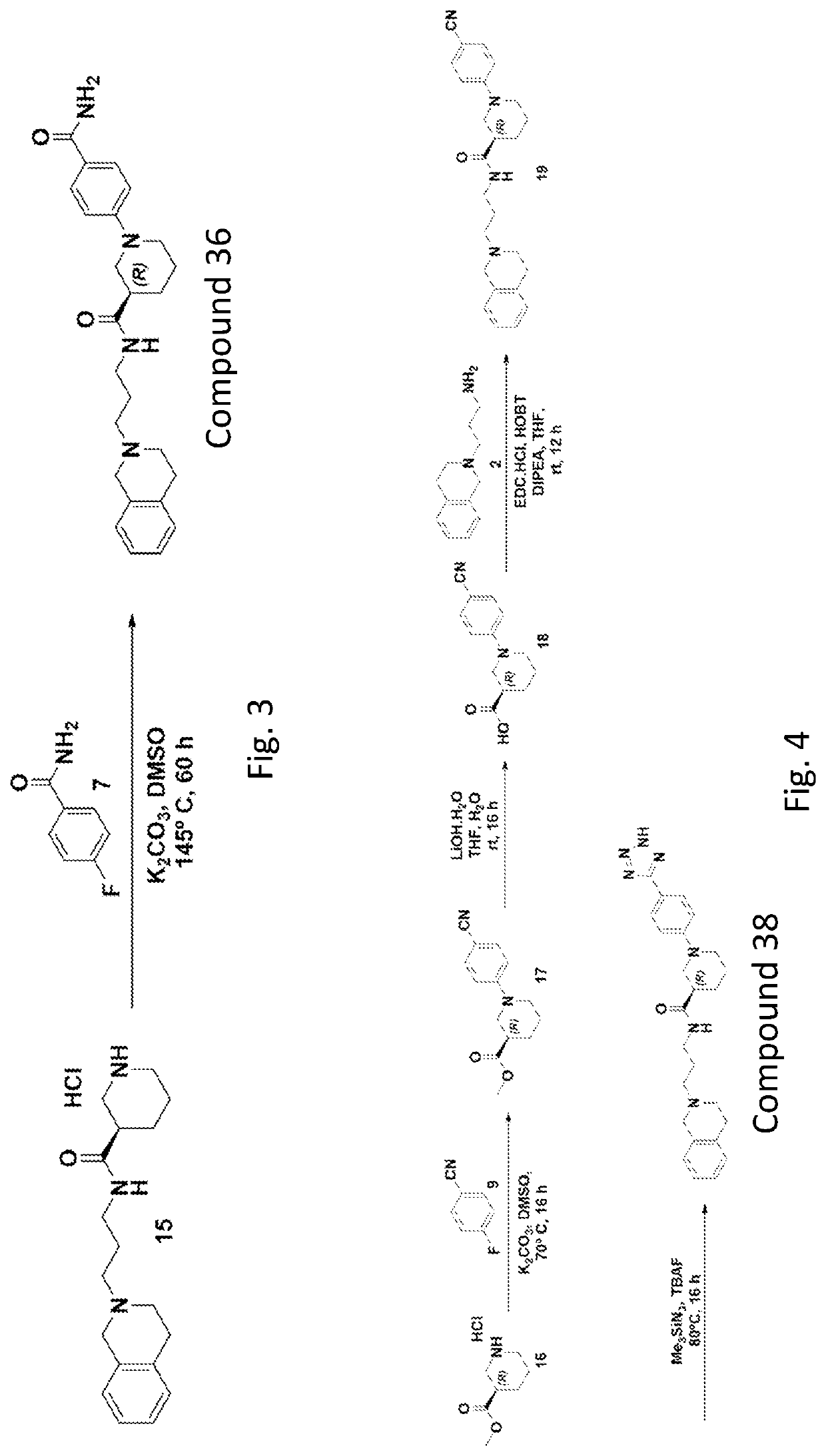Tlr 9 inhibitors
a technology of tlr9 and inhibitors, applied in the field of compounds, can solve the problems of inability to selectively inhibit tlr9, prolonged inflammation is not desirable, and the inhibitors of tlr9 have been known to be unselective,
- Summary
- Abstract
- Description
- Claims
- Application Information
AI Technical Summary
Benefits of technology
Problems solved by technology
Method used
Image
Examples
example 1
[0289]The compounds of the invention can be prepared using the following procedure.
Compound 1: 1-(4-Cyanophenyl)-N-(3-(3,4-dihydroisoquinolin-2(1H)-yl)propyl)piperidine-4-carboxamide
[0290]
[0291]Method A. 1-(4-Cyanophenyl)-N-(3-(3,4-dihydroisoquinolin-2(1H)-yl)propyl)piperidine-4-carboxamide. To a solution of 1-(4-cyanophenyl)piperidine-4-carboxylic acid (1 mmol, 230 mg) in DMF (2 mL) CDI (1 mmol, 162 mg) was added, and the mixture was stirred at ambient temperature for 1 h, then 3-(3,4-dihydroisoquinolin-2(1H)-yl)propan-1-amine (1 mmol, 190.28 mg) was added. The mixture was stirred at ambient temperature overnight. The solvent was removed under reduced pressure, diluted with dichloromethane and washed with 5% aqueous solution Na2CO3. Layers were separated, the organic one dried over Na2SO4, filtered and concentrated under reduced pressure. The obtained residue was purified by column chromatography on silica gel to yield 1-(4-Cyanophenyl)-N-(3-(3,4-dihydroisoquinolin-2(1H)-yl)propyl)...
example 2
[0334]FIG. 1 shows an example embodiment of a synthesis protocol for preparing Compound 32. The synthesis includes the following steps regarding reagents and / or intermediates to result in Compound 32.
Synthesis of 1-(4-carbamoylphenyl)-N-(3-(3,4-dihydroisoquinolin-2(1H)-yl)propyl)piperidine-4-carboxamide (Compound 32)
[0335]To a stirred solution of N-(3-(3,4-dihydroisoquinolin-2(1H)-yl)propyl)piperidine-4-carboxamide hydrochloride salt 4 (350 mg, 1.04 mmol) in DMSO (5 mL) were added 4-fluorobenzamide 7 (290 mg, 2.08 mmol) and potassium carbonate (716 mg, 5.18 mmol) at room temperature under inert atmosphere. The resulting reaction mixture was stirred at 155° C. for 40 h. After completion of reaction (TLC monitoring), the reaction mixture was diluted with ice-cold water (50 mL) and extracted with DCM (3×25 mL). The combined organics was washed with brine solution (150 mL), dried over Na2SO4, filtered and evaporated under reduced pressure to get the crude residue which was purified by R...
example 4
[0363]Select compounds were used for screening as antagonists for human TLR2, TLR3, TLR4, TLR5, TLR7, TLR8, or TLR9. The screened compounds include: compound 32; compound 34; compound 36, compound 38, compound 39, and compound 45. The studies were conducted as described herein. The following table shows the antagonistic activity and inhibiting of TRL9 over the other TLRs.
hTLRhTLRhTLRhTLRhTLRhTLRhTLRComp. IDNull2345789Agonist100%100%100%100%100%100%100%100%Compound 32134%102%101% 99%103% 90% 97% 50%Compound 34112% 93% 85% 88%102% 81% 82% 50%Compound 36 90%107%107%115%109% 97%103% 73%Compound 38128% 92% 98%150%105% 76%106% 82%Compound 39131% 99%108%110%108% 88%113% 48%Compound 45117% 93% 97% 89%100% 85% 98% 9%
[0364]Activation of the SEAP reporter is detected as OD value. OD value is subtracted by average non-induced (NI) value. The NI subtracted duplicates are averaged and presented in a histogram format hereafter. The values in the tables are the corresponding OD values for the Agon...
PUM
| Property | Measurement | Unit |
|---|---|---|
| temperature | aaaaa | aaaaa |
| total volume | aaaaa | aaaaa |
| total volume | aaaaa | aaaaa |
Abstract
Description
Claims
Application Information
 Login to View More
Login to View More - R&D Engineer
- R&D Manager
- IP Professional
- Industry Leading Data Capabilities
- Powerful AI technology
- Patent DNA Extraction
Browse by: Latest US Patents, China's latest patents, Technical Efficacy Thesaurus, Application Domain, Technology Topic, Popular Technical Reports.
© 2024 PatSnap. All rights reserved.Legal|Privacy policy|Modern Slavery Act Transparency Statement|Sitemap|About US| Contact US: help@patsnap.com










